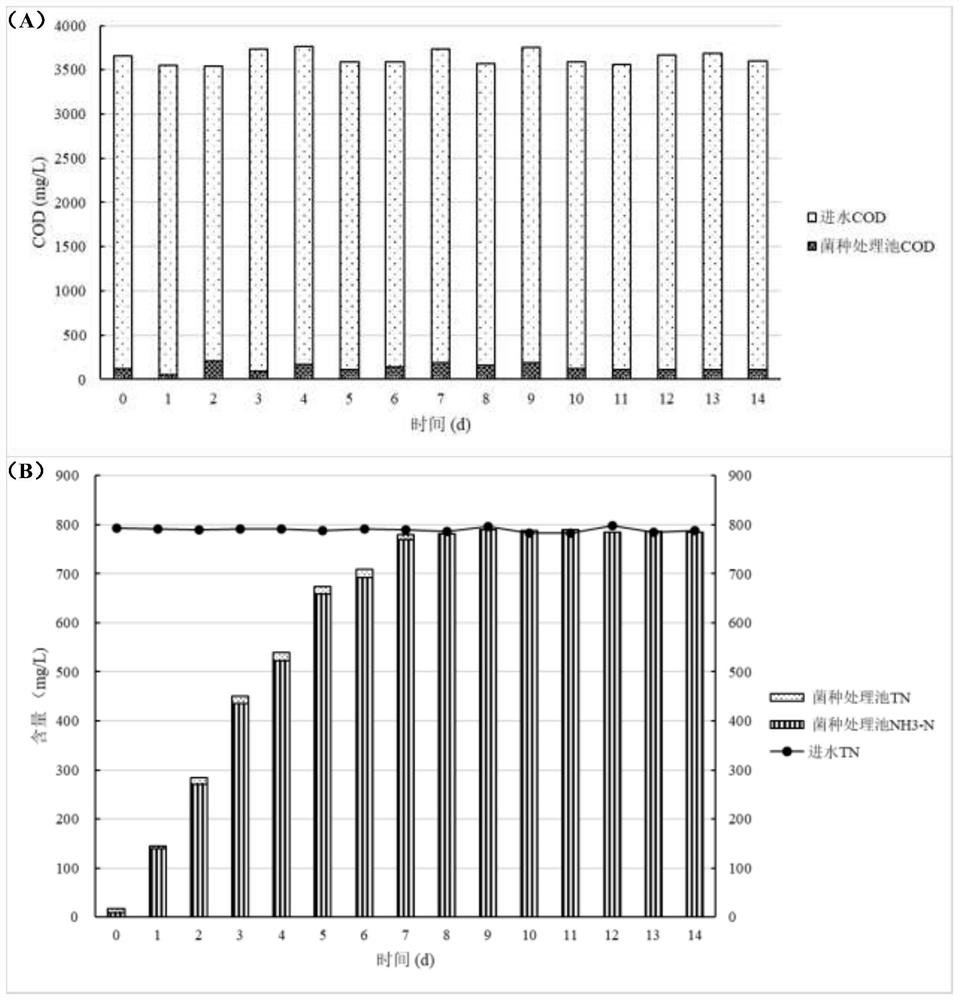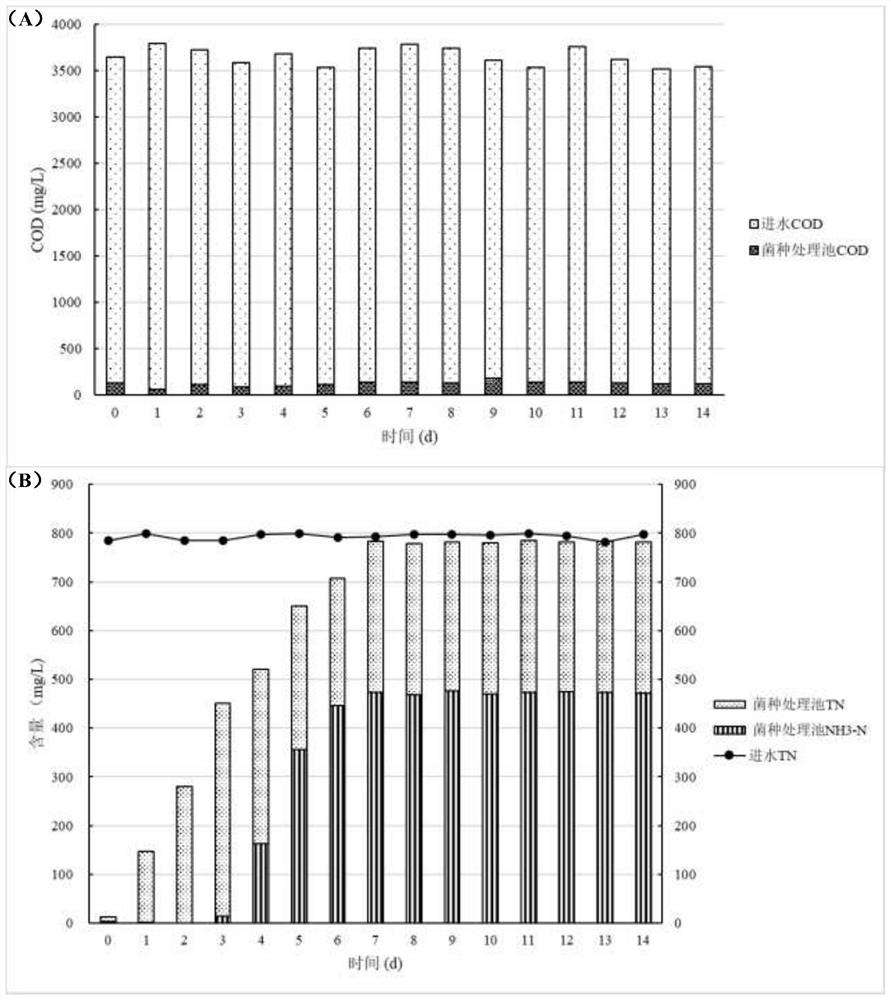Paracoccus thiooxidans capable of efficiently degrading DMF (Dimethyl Formamide) and application of Paracoccus thiooxidans in treatment of DMF-containing wastewater
A technology of sulfur oxide and paracoccus, applied in biological water/sewage treatment, water/sludge/sewage treatment, bacteria, etc., can solve the problem of less research, and achieve the effect of high DMF tolerance, high efficiency and stable application
- Summary
- Abstract
- Description
- Claims
- Application Information
AI Technical Summary
Problems solved by technology
Method used
Image
Examples
Embodiment 1
[0047] Embodiment 1: preparation culture medium
[0048] Three media were prepared according to the following recipes:
[0049] Inorganic salt medium (g / L): KH 2 PO 4 1.2, K 2 HPO 4 6.8, NaCl 0.5, MgSO 4 ·7H 2 O 0.1, MnSO 4 ·H 2 O 0.1, CaCl 2 0.1, FeSO 4 ·7H 2 O 0.1, Na 2 MoO 4 2H 2 O 0.006, CuSO 4 ·5H 2 O 0.006, ZnSO 4 ·7H 2 O 0.007, CoCl 2 ·6H 2 O 0.0001, H 3 BO 3 0.0124, vitamin B1 0.00001, with DMF as the sole carbon source and nitrogen source, pH=6 (add 2% agar powder by mass fraction to the solid medium).
[0050] LB medium (g / L): peptone 10.0, yeast extract 5.0, NaCl 10.0, pH=7 (solid medium with 2% mass fraction of agar powder added).
[0051] DMF1 medium: Add 0.2g / L DMF and 0.2g / L dimethylamine to LB medium.
Embodiment 2
[0052] Embodiment 2: Strain domestication, isolation and identification
[0053] (1) Strain domestication:
[0054] Inoculate 10 mL of fresh sludge from each pharmaceutical factory into a Erlenmeyer flask filled with 100 mL of inorganic salt medium (DMF concentration: 1000 mg / L), and place it in a shaking incubator at 30 °C and 130 r / min for 1 week. Take samples every other day to detect TN and NH in the system 3 -N value. After 1 week of culture, the NH in the system 3 -N obviously increased to about 160mg / L, and the ammoniation rate of TN reached over 90%. Transfer to fresh inorganic salt culture medium (DMF concentration is 2000mg / L) according to 10% inoculum amount again, monitor the TN and NH in the system 3 -N value, continue culturing for 1 week. Continuous transfer was performed 5 times, and the DMF concentration was gradually increased to 5000 mg / L.
[0055] Note: Ammonification refers to the conversion of organic nitrogen in TN into NH 3 -N.
[0056] (2) Stra...
Embodiment 3
[0064] Embodiment 3: single bacterium degrades DMF ability
[0065] (1) Seed liquid preparation:
[0066] The 4 strains P.sulfuroxidans 175A1-1, Aquamicrobiumlusatiense 3-1-1, Gelidibacter flavus 2-CZ-5, and Sphingomonas paucimobilis 3-3-10 isolated in Example 2 were amplified and cultured in LB medium to OD 600 All reached about 1.5, centrifuged at 6000r / min for 3min, discarded the supernatant, and took the bottom bacteria. Then resuspend with sterile distilled water to prepare seed solution.
[0067] (2) Experimental device:
[0068] The experimental device is a continuous water inlet and outlet device, which simulates the on-site treatment system to the greatest extent to test the treatment effect of bacteria on DMF. The complete set such as Figure 5 As shown, it includes the water inlet pool, the strain treatment pool and the water outlet pool connected in sequence. The effective volume of each pool is 3L, the water inlet pool is used to add nutrients to adjust the ...
PUM
| Property | Measurement | Unit |
|---|---|---|
| clearance rate | aaaaa | aaaaa |
Abstract
Description
Claims
Application Information
 Login to View More
Login to View More - R&D
- Intellectual Property
- Life Sciences
- Materials
- Tech Scout
- Unparalleled Data Quality
- Higher Quality Content
- 60% Fewer Hallucinations
Browse by: Latest US Patents, China's latest patents, Technical Efficacy Thesaurus, Application Domain, Technology Topic, Popular Technical Reports.
© 2025 PatSnap. All rights reserved.Legal|Privacy policy|Modern Slavery Act Transparency Statement|Sitemap|About US| Contact US: help@patsnap.com



